

Blue is one of the most peaceful colors, and it makes sense that we find blue birds to be some of the most calm and relaxing birds around. It isn’t as common a color to see on birds in North America, so it really stands out when encountered. In this article we will choose our favorite 16 types of blue birds.
While create red pigment from the foods they eat, blue birds cannot do this. In fact, there aren’t any bird species that actually create blue pigment. Instead, the blue color of their plumage is all optics and is created by the way light waves interact with their feathers. Here are 16 types of blue birds that have managed to express all different shades of blue.

Scientific name:
The Blue Grosbeak makes its home among bushes and untended fields in the southern United States and Mexico. You may see it flicking and moving its tail around as it perches on the edge of a thicket.
Only males have the bright blue feathers on nearly their entire body. Coppery colored bars on their wings provide a dynamic color change that helps them stand out. Females are coppery brown colored with only tinges of blue.

Scientific name:
The male Mountain Bluebird is one of the brightest blue-colored birds in western North America, with a sky blue front and bright cerulean back. Females in comparison are drab, with a mostly pale gray body with only touches of blue. This omnivorous bird eats berries, insects, and caterpillars.
Mountain bluebirds breed in the Rockies and mountainous areas that stretch from Utah all the way up through Alaska. They prefer to winter where its warmer though, and can be spotted in eastern California, West Texas, and most of Arizona and New Mexico.
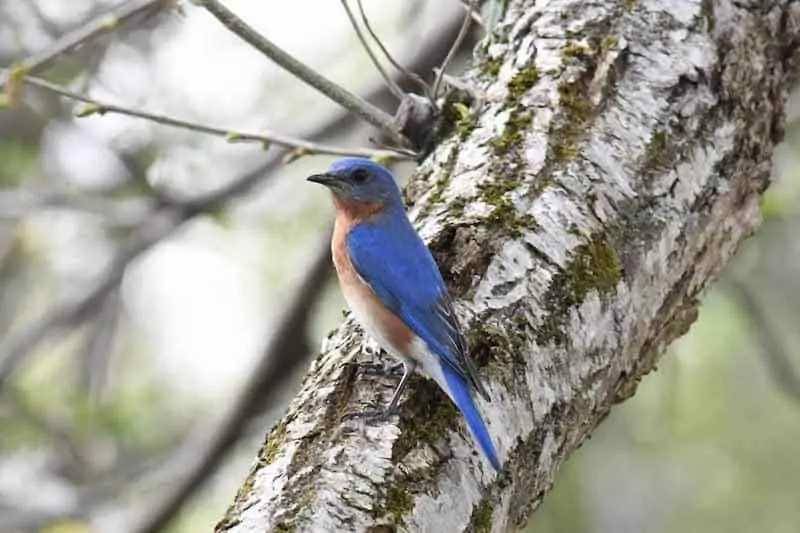
Scientific name:
True to their name, bluebirds are all blue on top with rusty . Females and males share the same coloration, however the females colors appear much duller and more faded, especially the blue. The main difference between eastern and western varieties lies with the males. Male Western Bluebirds have blue on the throat instead of orange, and the orange on their chest extends back over the tops of the wings, like suspenders.
If you’re an avid bird watcher, you may know that bluebirds adapt very well to suburban climates. Unlike their mountain cousin, they will readily make their nests in nest boxes provided by people. In recent years, this has helped their numbers improve dramatically!
to your yard by putting out dried or live mealworms. Since both parents raise young, your yard may even become a food depot for busy parent bluebirds trying to feed all the chicks in their nest.

Scientific name:
One of the most vibrant blue birds in the Eastern United States, the Indigo Bunting is hard to miss as it flutters along a roadside or . Only males have the characteristic blue feathers, females are a nondescript brown.
Spot Indigo Buntings during the summer months throughout all of the Eastern United States. Females do all the work of making the nest and raising the chicks, so she’s harder to spot. Indigo Buntings are one type of songbird that at night!

Scientific name:a
If you’ve ever heard a characteristic call, you may think they have an almost electronic or metallic sound. These blue, white, and black-patterned birds are both large and intelligent. They are opportunists that will visit your feeder and forage for nuts and insects on the ground. They are common in the eastern U.S. and many parts of Canada.
One interesting fact about Blue Jays: They harvest acorns from oak trees, then store them inside holes in the ground for later access once food supplies are scarce. Sometimes their call can act as an alarm to other birds that indicates predators, and they can even mimic hawk sounds.

Scientific name:
The Tree Swallow is known as a graceful in flight, gliding and swooping over lakes and meadows to catch insects in mid-air. From below they appear all white, while the top of their head, back and wings are an iridescent greenish-blue.
Tree Swallows prefer to breed in Canada and the northern United States. They spend their winters along the coasts in the South, Gulf Coast, and Baja Peninsula. A population lives year-round in Southern California.
Interestingly, Tree Swallows prefer the exact same kind of nest habitat as Eastern Bluebirds. In many areas, they use vacant holes and nest boxes that the bluebirds would use.
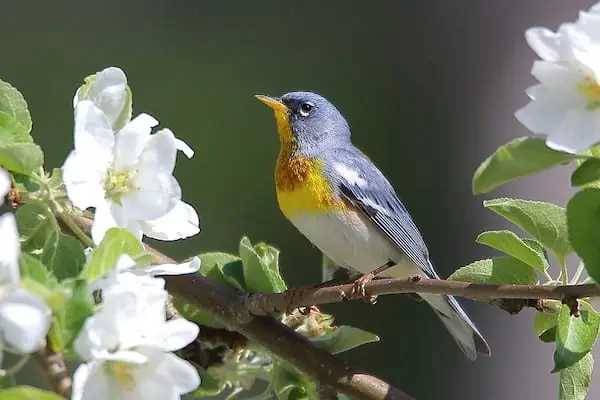
Scientific name:
Bedecked in a variety of bright patches of yellow, blue, and white, the Northern Parula is hard to spot in dense treetops but it is definitely easy to hear. The sound is buzzy and can be heard throughout spring and summer.
Northern Parulas are members of the warbler family that migrate south during the winter. During the breeding season, they make their homes around the southeastern United States or in a strip of habitat from northern Minnesota all the way east to Newfoundland.
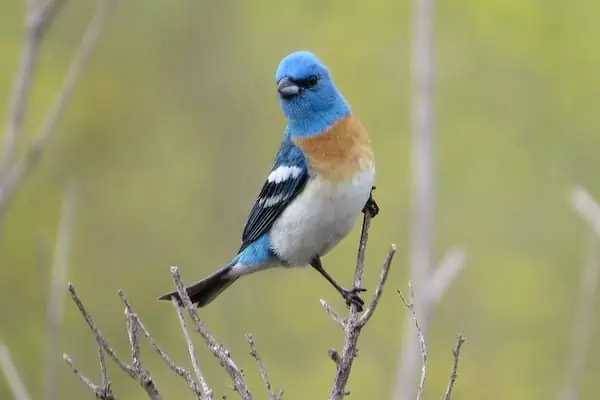
Scientific name:
You might worry about mistaking a Lazuli Bunting for an Indigo Bunting. Don’t worry about that – there are several ways to tell them apart. While only the males of both species are blue, Lazuli buntings aren’t completely blue-feathered. They have a brown breast and a white belly.
Lazuli Buntings are native to the Western United States, not the East. Their call is higher and clearer than their Indigo cousins.
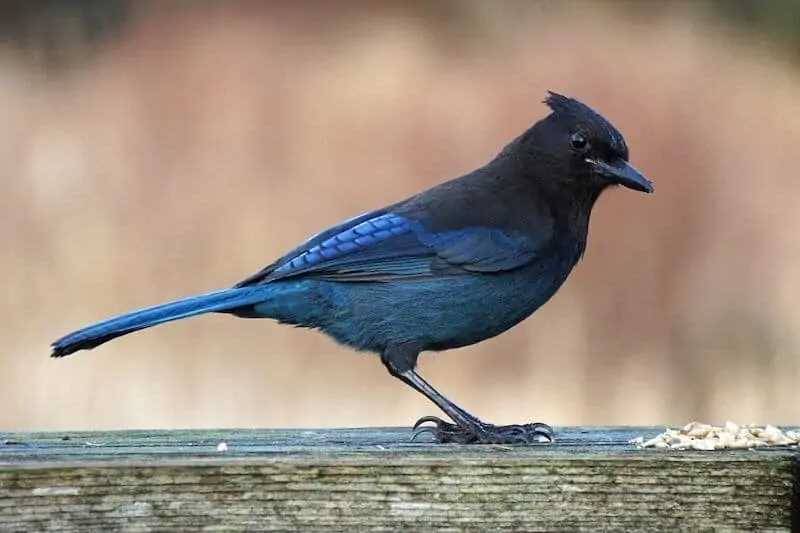
Scientific name:
Dynamic and gregarious, this jay has a beautiful blue gradient of gray to blue feathers from its crest to tail. Both males and females have this dramatic coloring. Like other Jays, they use their beaks to break open acorns and seeds. They may fly together in flocks.
Look for Steller’s Jays in the western half of the United States. They don’t migrate and live year-round in the Rocky Mountains, the Southwest, and the Pacific Northwest all the way up to Alaska.

Scientific name:
The California Scrub-Jay is a fairly large songbird with beautiful blue coloring on it’s head, back and tail. Across their upper back is a patch that can appear gray or brown. It’s chest and belly are mostly white, with some blue feathers that come around the front like “necklace”.
They are known for having a boisterous personality, both with frequent vocalizations and the way they bounce around and always seem to be cocking their heads and hatching schemes. The California Scrub-Jay sticks around all year, and can be found throughout northern, coastal and central California.
Two very similar looking species are the Florida Scrub Jay (central Florida) and Woodhouse’s Scrub Jay (southwestern U.S.).
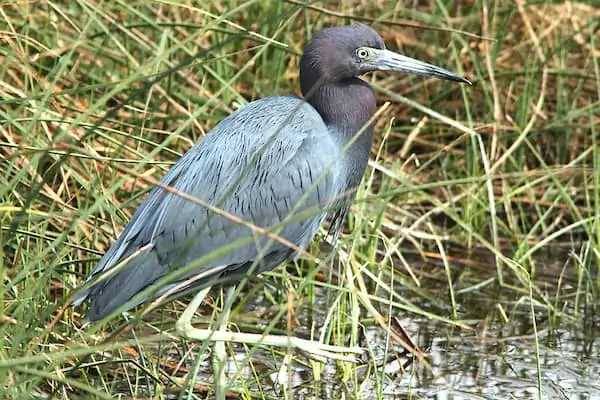
Scientific name:
Named because of its smaller stature compared to the Great Blue Heron, the Little Blue Heron looks similar to its larger cousin in most respects. Both male and female adults are adorned with the same dusky blue plumage. They are shy, even among their own kind, and prefer to nest along the edges of large breeding colonies.
Look for Little Blue Herons around swamps, inland marshes, and freshwater sources of standing water along costal areas of the southeastern U.S. and the Gulf of Mexico. Young herons are white and look similar to Snowy Egrets until they molt into their adult feathers.
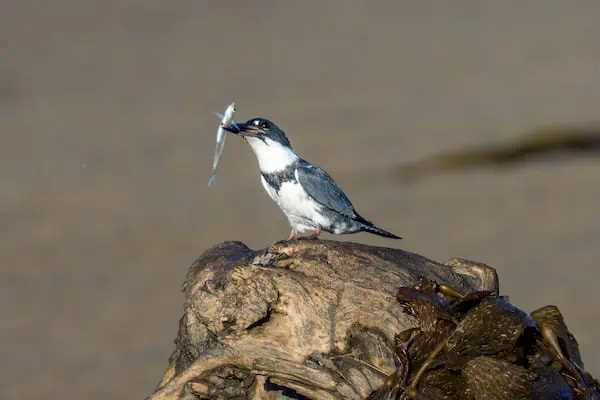
Scientific name:
While it seems comically disproportionate with its large beak and head, the Belted Kingfisher is perfectly adapted to its preferred habitat: streams, riversides, and coasts. To hunt, the kingfisher perches on a branch over water. When its spots a suitable fish, it dives into the water and snatches the prey with its powerful bill.
Both males and females have similar coloring that includes a dark, powdery blue on the head, crest, back, wings and “necklace”. Males have a white belly, while females bellies are white with brown striping.

Scientific name:
This dusky blue-gray bird can be spotted throughout much of the United States during the summer, from Pennsylvania to California. Populations live year-round in Florida and along the Gulf Coast, as well as throughout Mexico. They prefer to live in forests with open space and deciduous trees. They also like to be near water.
If they catch an insect that’s too large to eat in one bite, Blue-gray Gnatcatchers will beat it against a tree branch to break it up before eating it!
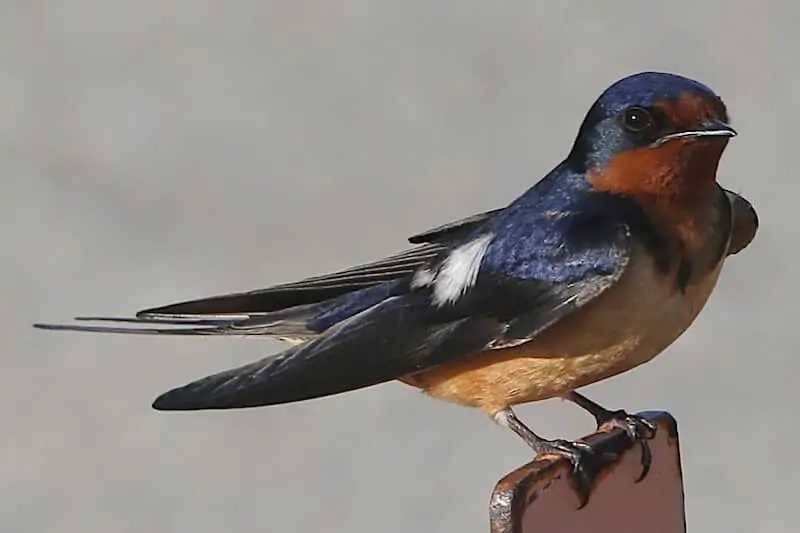
Scientific name:
Barn swallows sport a deep purple-blue or navy-blue on their head, back and wings. This is complemented by an orange face and belly.
These birds are some of the most successful at adapting to human infrastructure. They are opportunists that build nests anywhere from docks to the eaves of buildings. Both parents work together to craft the nest out of mud and grass. Along with the parents, adult chicks from an earlier brood will sometimes help out by bringing food to the young.
Spot Barn Swallows throughout the United States, mostly in the spring and summer months.

Scientific name:
The male of this species has a dark blue back that reaches from the top of i’s head down through the tail. He also sports a black mask and white underparts. Females look completely different with plain olive-gray plumage.
Black-throated Blue Warblers spend the winter in the Caribbean, then migrate into the eastern U.S. in the spring. Look for them around the Great Lakes and the northeast. Unlike some warblers that like to stay high in the treetops, these guys prefer the lower canopy and shrubby understory.

Scientific name:
The male Cerulean Warbler is a striking sky blue that can even appear turquoise in the right light. They have a white throat and black streaking. Like other warblers, females appear different with yellow feathers that have a slight blue wash.
These warblers spend the winter in northern South America, then travel all the way to the U.S. to spend their summer in Pennsylvania, Ohio, Indiana, Illinois, Kentucky, Tennessee, Michigan and Wisconsin.


















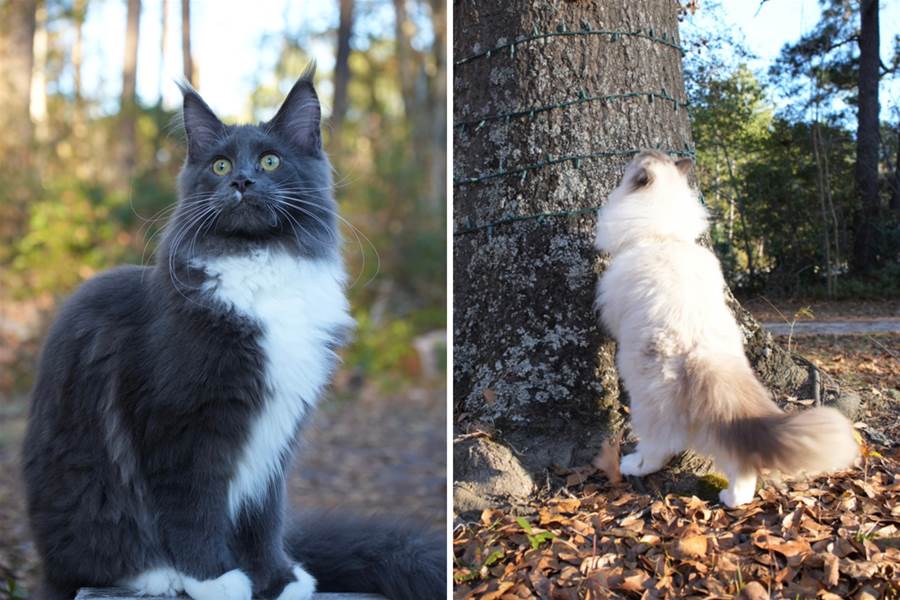

代表者: 土屋千冬
郵便番号:114-0001
住所:東京都北区東十条3丁目16番4号
資本金:2,000,000円
設立日:2023年03月07日
